10 Day Sacred Buddha Retreat
Sep 26 - Oct 5, 2024
in Tibet
with Shaman, TedX Speaker Johnson Chong
& ex- monk PhD Buddhist scholar Dr. Karma
What's Included
- 50 Hour Buddhism & Meditation Online Course Preparation
-- Pre-Travel Zoom Group Meeting
- 10 x 75 min Daily Yoga & Meditation Classes
- 5 x Shamanic Breathwork Journey Workshops
- 5 x Ajna Light Therapy Meditations
- Cultural Programs & Activities (hikes, temple visits, etc)
- All Meals (Breakfast, Lunch &
Dinner)
- Evening Tea
- 5 Star, 4 Star and 3 Star Accommodations
- All local Transport by coach within Tibet
- 1 Group Transport to and from the
Airport
- Services of English speaking expert guides through Tibet
- Special Entry Fees
- Group Permit for entry to Tibet.
Walk the Sacred Path of the Buddhas
The Pilgrimage
This unique experience is a blend of personal development and spiritual adventure. When you land, you will engage with all the healing processes, meditations, yoga practices, breathwork healing journeys with full concentration and participation. When you engage with prayer, offer and meditations in the temples, you will do so with your whole being regardless of whether you are an admirer or devout practitioner of Buddhism. As a pilgrim, you will lean fully into your soul’s purpose, and earnestly command the sky and the earth to pave a path of love, joy, abundance and grace to form for not only you, but for all of humanity.
Daily Yoga
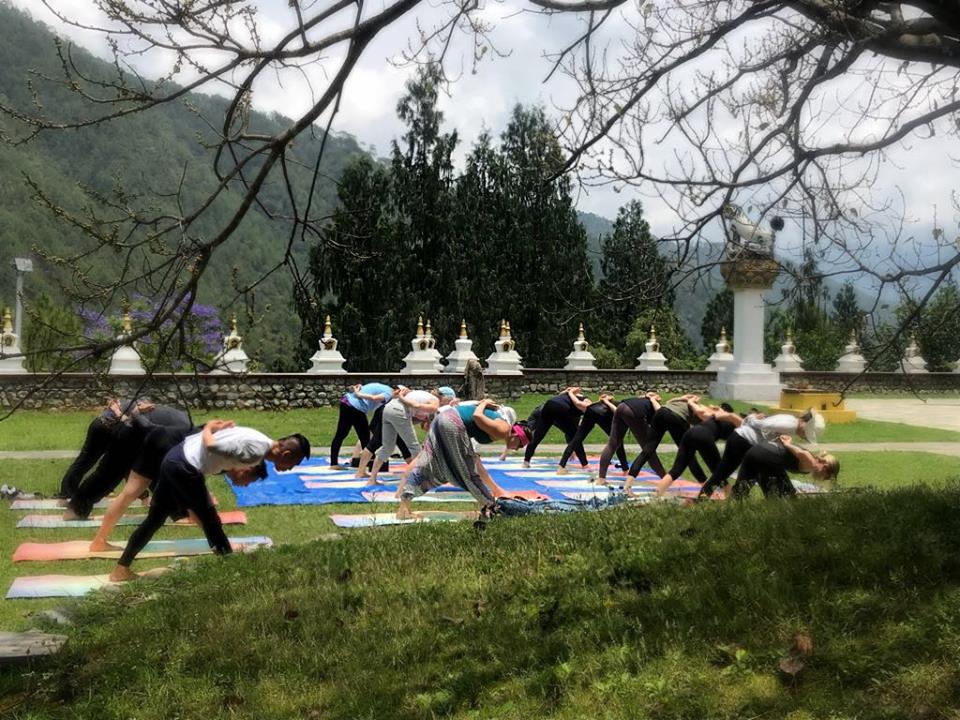
Shamanic Breathwork Journeys
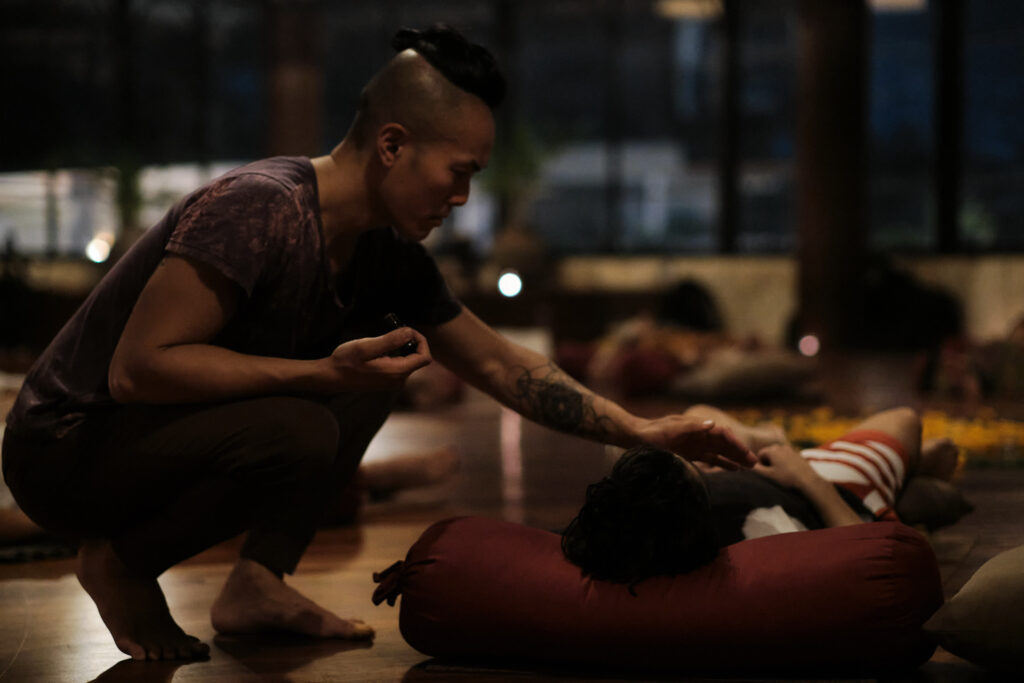
Breathwork helps to prime the mind, body and energy systems to tap into your ability to entrain peace through meditation. You will also connect with your Spirit guides by invoking the sacred energies of the Andean medicine wheel. Drop into your inner guidance in expanded states of consciousness like you’ve never before.
Buddhist Chanting & Meditation
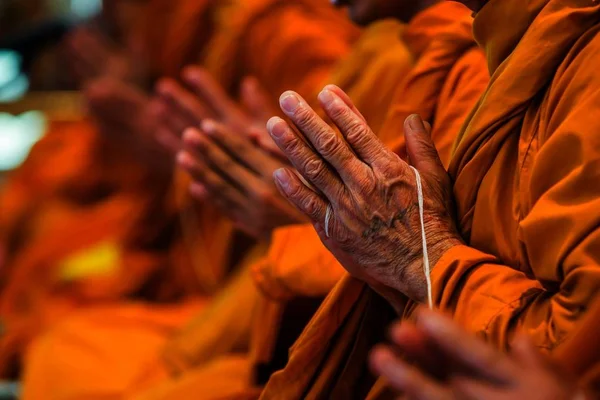
In the land of the Buddhas, chanting is one of the main practices in the monasteries. The simple practice of using sound to tame the monkey mind creates a profound sense of peace in the nervous system.
Psychedelic Light Therapy
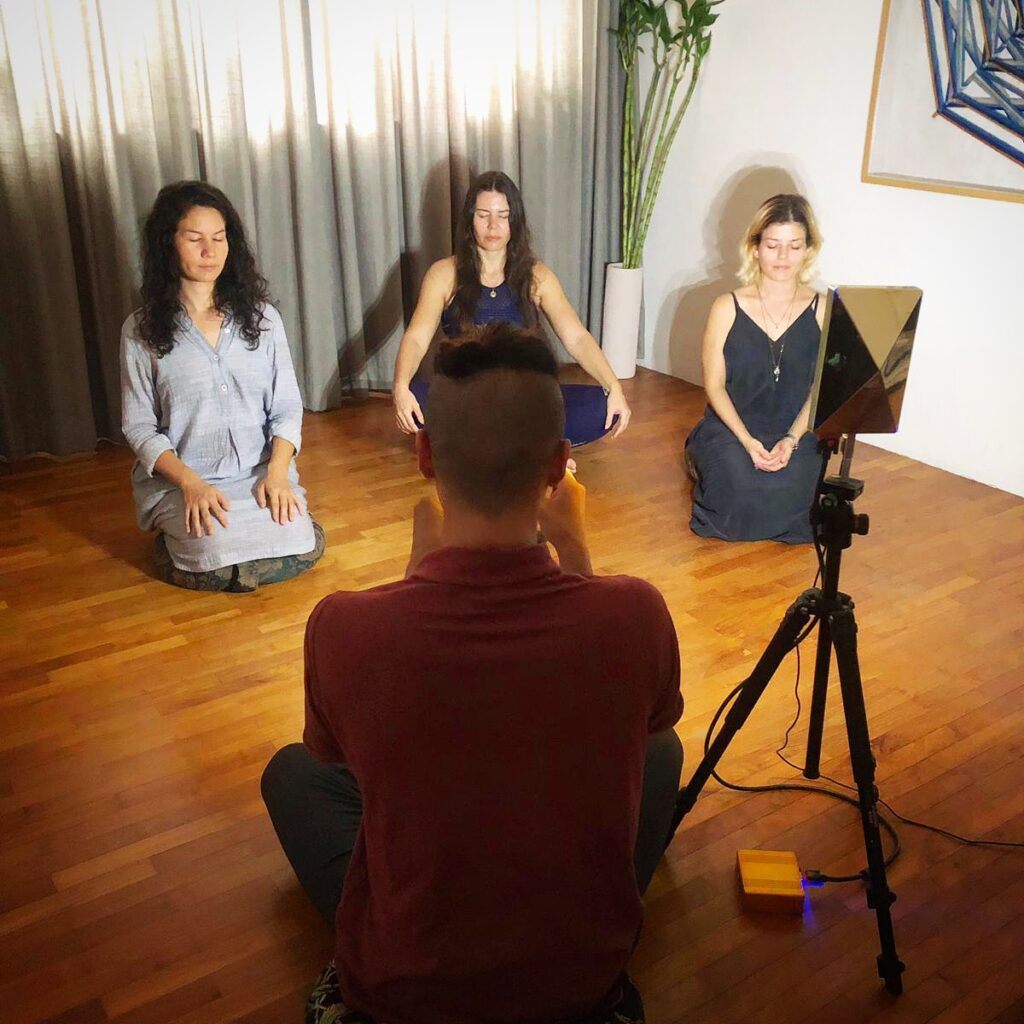
The Ajna light is a meditation device that uses LED lights to stimulate a psychedelic DMT state of consciousness without ingesting hallucinogens. Oftentimes, students report seeing a kaleidoscope of visions similar to when on a psychedelic trip, except without the physical side effects of nausea.
I loved starting the day with a good yoga practice and breathwork. You really feel so energised after that. I know quite a lot about nutrition already, but coming to the retreat showed me that there is so much more to learn. If I had to summarise this retreat in one word, it would be self-love.
Tammy Boh Calabro
Italy
I really loved this retreat because it was a combination of seeing Bhutan and going through a personal journey. We have been doing yoga every day, and shamanic healing journeys with Johnson. I liked the shamanic journeys because it was something that I’ve never done before and I found it very spiritual and also very illuminating.
Helit Greenfield
New York, USA
Today we went to the oldest temple and we went into the oldest part of it that was from the 7th century. That was very moving. Although I don’t always pick up on energy. I felt enormous energy in that place. One thing that I learned for my meditation practice, is that the Buddhist way seems to use symbols to pray and meditate with. And symbology was not something that I thought too much about. But, I must say that it has helped me to get to a clear state in meditation.
Howard Cramer
London, UK
We did this fabulous trek up to Tiger’s Nest, and I had this injury. I just couldn’t walk down. Somebody carried me half the way down and found me a horse. When we tried to thank these people, they said ‘it’s our honour.’ You saw the real base of generosity and compassion that people had. That was a moving experience.
Judith MacCormick
Sydney, Australia
We’ve done some many amazing things, rafting down rivers, going to temples and seeing so many fascinating things. We did a number of workshops every day, and the shamanic journeys were something I’ve never done before. You can actually feel the energy move through your body. I would happily do it all over again.
Deborah Travers
Sydney, Australia
The biggest highlight was my visit to the fertility temple, as I am currently going through a journey in that area. Through this trip, I really started thinking about this yin/yang balance. And my biggest takeaway is to shift my consciousness to more of my feminine side so that I have more balance.
Miki Hata
Sydney, Australia
Bhutan is magical and very beautiful. I came here with no specific things in mind. I didn’t know what to expect. I learned a lot about myself. I learned about the attachments, fears and my personality. It was enlightening for me, and now I am feeling freer from those attachments.
Cahê Toporowicz
Brazil
It has been really intense, but I feel that I can connect with my true essence now. During these 10 days, we did yoga, meditation, walked to sacred temples and connected inwards through shamanic journeys to clean our energy bodies. I would highly recommend this trip if you’re wanting to reconnect with your true inner self.
Mayra Andrade
Brazil
Johnson did an incredible job bringing a group of diverse people from multiple countries, and it’s just been a wonderful experience. I would highly recommend taking this journey with an experienced team of people like we have. It makes the experience so much richer to have the guidance of people who can bring the community together and make it relatable.
Diana Schmidt
North Carolina, USA
What I learned from some of the workshops that we were doing was that I am exactly where I need to be in my life. And that is something that I normally struggle with, comparing myself with others. I ended up in Bhutan for a reason. It had a very profound impact on how I look at my life.
Artem Gorobets
Sydney, Australia
Your Guides on this Journey
Dr. Karma Wangchuk

As a practitioner of the Nyingmapa and Kagyupa traditions of Mahayana & Vajrayana Buddhism for many years, Dr. Karma has been established with the aim to serve and guide especially spiritual and Dharma seekers through theoretical and practical experiences while in the Kingdom of Bhutan, Nepal & Tibet.
For eight years between 1986 – 1994, he lived as a Buddhist monk under Kalu Rinpoche and Drupchen Rinpoche. During his monk-hood, he acquired a Gold Medal in his M.A Buddhist Studies Program, and proceeded to earn a PhD from the University of Delhi in Buddhist Studies.
He is a sought after lecturer in Tibetan Buddhism and Spirituality, and has held various positions in the government and privately. Currently, Dr. Karma is the lead trainer in the Tourism Council of Bhutan teaching other guides how to present Buddhism.
With Dr. Karma as our guide, we will surely experience an extraordinary layer of cultural immersion unlike any other average ‘tour’. We traverse the land of the Buddhas not only with a cultural guide, but a spirit guide.
Dr. Karma speaks English, Bhutanese & Tibetan.
Johnson Chong

Johnson Chong is the best-selling and award-winning author of Sage Sapien: From Karma to Dharma. He is also a TedX Speaker, shaman and the founder of Sage Shamanic Yoga where he trains aspiring meditation and breathwork teachers. Through the synthesis of the most applicable teachings of yoga, meditation, breathwork, coaching and shamanic healing, his trainings are designed to help people quiet the mind, awaken the heart and free themselves of the roadblocks that keep them from living more authentically and joyfully. He has spoken and led workshops at companies like Unilever, Facebook, Nike, Macquarie, Insight Timer, UBS, UOB and more.
Johnson is a native New Yorker, and has lived on 3 continents, currently based in Sydney, Australia.
His passion is creating a bridge between ancient wisdom, energy medicine and direct modern application. Clients say that his unique experiences of er a profoundly healing self-discovery experience, followed with very practical and actionable steps to create lasting change. As a paqo shaman of the Q’ero lineage, a Four Winds Energy Medicine Health Coach, and
Reiki Master, in conjunction with his background as a teacher who trains yoga teachers and pilates teachers, he has an expansive knowledge of the physical body and how the psyche can create stagnation on all dimensions of being: physically, mentally, emotionally and on the level of the energetic.
Local Cuisine
Tibet’s cuisine reflects its wintery landscape. Staples include flour made of roasted barley, dairy (butter, milk & cheese) and meat (mutton, pork & yak). People who live in higher elevations typically consume more meat where as the lower regions have more access to a variety of vegetables. Rice is typically eaten by families of a higher economic background, southern border farmers and monks. You’ll also notice tea and barley beer (chhaang) commonly served.
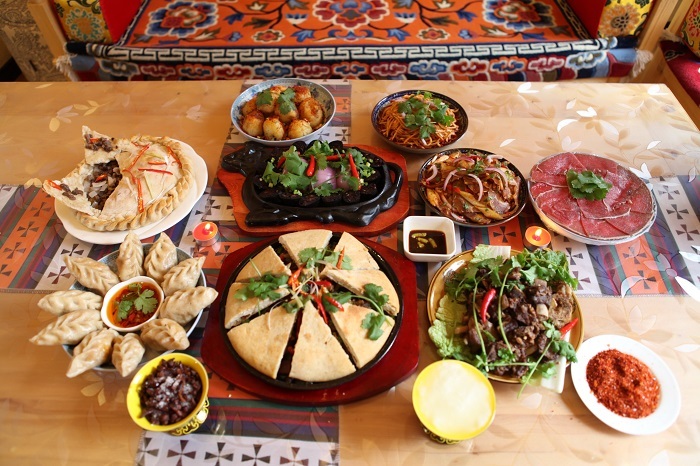

Accommodations
During this pilgrimage, you will stay at the 5 star Shangrila in Lhasa, followed by 4 and 3 star accommodations as we move further out from the capital toward the remote regions due to what is available






The Itinerary
*This retreat schedule, program and itinerary is subject to minor changes depending on weather and unforeseen circumstances
Walk the Sacred Path of the Buddhas
More than a retreat, this is a spiritual pilgrimage across the sacred sites of the Himalayas. We will visit the holy temples and places that Guru Rinpoche (Padmasambhava) the 2nd incarnation of the Buddha. He is an integral part of the Himalayan culture as he was responsible for bringing Buddhism to Nepal, Bhutan & Tibet. As you walk the path of the Lotus born, you will connect with the core of the Buddhist teachings not just from the mind, but from the whole of you.
This is not a call for you to become a blind follower. It is a call for you to re-awaken your inner Buddha nature, and to walk the path alongside the ancient ones.
Walk the Sacred Land of the Buddhas on the Tibetan plateau
Exclusions:
• Flights
• International Travel Insurance (mandatory).
• Gratuities for guide and driver
(Average of $10-15 USD per day)
• Shopping & personal expenses
Room Options:
Rooms are priced in USD per person below and on first come first serve basis.
Limited to 12 participants.
• Twin Share $3800
• Private Room $4400
A $500 USD non-refundable deposit is required to hold your spot.
Tammy Boh Calabro
Italy
Deborah Travers
Sydney, Australia
Miki Hata
Sydney, Australia
Cahê Toporowicz
Brazil
Mayra Andrade
Brazil
Diana Schmidt
North Carolina, USA
Artem Gorobets
Sydney, Australia
The shamanic journeys were extremely profound for me. I feel like Johnson is truly a channel to the spirit world. What surprised me about this retreat was the connections with the people in the group. It was beyond my wildest dreams.
Sarah Bright
Sydney, Australia
What I learned about myself was how much fear I had before coming on retreat. But also how much strength and tenacity I have in going through this journey and these beliefs. I think this journey has been transformative. It has been really magical and heartfelt for me.
Joel Low
Singapore
What I found really healing is that Johnson was able to provide the space and compassion for me to let go of the family ancestry that was so abusive, without being invasive. He didn’t tell me how to do it, he allowed me to find it on my own.
Steffi Adams
Florida, USA
Let’s keep in touch
Subscribe to the mailing list and receive the latest updates


